Controlling CO/H2 selectivity in CO2 electrolysis via Ni-Co coordinated nitrogen-doped carbon in various pH conditions
IF 4.8
2区 化学
Q2 CHEMISTRY, PHYSICAL
引用次数: 0
Abstract
The electrochemical CO2 reduction reaction (eCO2RR) is a promising technology for achieving a carbon-neutral society by converting CO2 into value-added products using renewable energy. This study investigates Ni-coordinated nitrogen-doped carbon (Ni-NC) electrocatalysts for controlling CO and hydrogen selectivity in the eCO2RR under acidic conditions. Ni-NCs were synthesized by evaporating and calcining nickel nitrate, 2-methylimidazole, and carbon black precursors. The introduction of Co into Ni-NCs (Ni-Co-NCs) was explored to tune the hydrogen evolution reaction (HER) activity. X-ray absorption fine structure (XAFS) measurements confirmed the Ni-N and Co-N coordination in the synthesized electrocatalysts. Electrochemical tests in a flow cell reactor with an acidic electrolyte revealed that Ni-NCs exhibited CO selectivity over 90 % in the potential range of −1.0 to −1.5 V vs. RHE, whereas Co incorporation in Ni-Co-NCs enabled control over hydrogen selectivity. The CO/H2 ratio can be adjusted by varying the Ni and Co compositions, making the synthesized electrocatalysts suitable for syngas production via the Fischer-Tropsch process. Long-term stability tests demonstrated the robustness of the Ni-N active sites. Furthermore, the eCO2RR overpotential was reduced by increasing the electrolyte pH, which was attributed to the suppression of the competing HER. This study highlights the potential of Ni-NC and Ni-Co-NC electrocatalysts for practical CO2 conversion applications, such as tandem electrodes and synthetic gas production.
Ni-Co配位氮掺杂碳在不同pH条件下控制CO2电解CO/H2选择性
电化学二氧化碳还原反应(eCO2RR)是一种很有前途的技术,通过使用可再生能源将二氧化碳转化为增值产品,实现碳中和社会。研究了镍配位氮掺杂碳(Ni-NC)电催化剂在酸性条件下控制eCO2RR中CO和氢的选择性。通过蒸发和煅烧硝酸镍、2-甲基咪唑和炭黑前驱体合成了ni - nc。研究了在ni - nc (ni -Co- nc)中引入Co以调节析氢反应(HER)活性的方法。x射线吸收精细结构(XAFS)测试证实了所合成的电催化剂具有Ni-N和Co-N配位。在酸性电解质的流动电池反应器中进行的电化学测试表明,在- 1.0至- 1.5 V与RHE的电位范围内,ni - nc的CO选择性超过90 %,而CO掺入ni - CO - nc可以控制氢的选择性。通过改变Ni和CO的组成可以调节CO/H2比,使所合成的电催化剂适合于通过费托法生产合成气。长期稳定性试验证明了Ni-N活性位点的稳健性。此外,通过增加电解质pH降低eCO2RR过电位,这归因于抑制竞争HER。这项研究强调了Ni-NC和Ni-Co-NC电催化剂在实际二氧化碳转化应用中的潜力,如串联电极和合成气生产。
本文章由计算机程序翻译,如有差异,请以英文原文为准。
求助全文
约1分钟内获得全文
求助全文
来源期刊

Applied Catalysis A: General
化学-环境科学
CiteScore
9.00
自引率
5.50%
发文量
415
审稿时长
24 days
期刊介绍:
Applied Catalysis A: General publishes original papers on all aspects of catalysis of basic and practical interest to chemical scientists in both industrial and academic fields, with an emphasis onnew understanding of catalysts and catalytic reactions, new catalytic materials, new techniques, and new processes, especially those that have potential practical implications.
Papers that report results of a thorough study or optimization of systems or processes that are well understood, widely studied, or minor variations of known ones are discouraged. Authors should include statements in a separate section "Justification for Publication" of how the manuscript fits the scope of the journal in the cover letter to the editors. Submissions without such justification will be rejected without review.
 求助内容:
求助内容: 应助结果提醒方式:
应助结果提醒方式:


